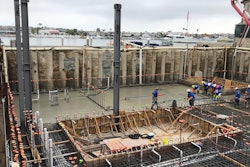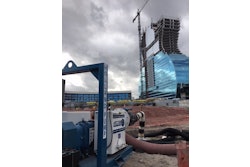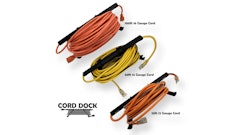
Few things are worse for a construction contractor eager to begin work on a new job than excess water. That is why dewatering processes are so instrumental in prepping construction sites.
This guide will help construction site managers and planners understand the basics of dewatering, explore the benefits of construction site dewatering, and offer best practices and helpful tips on effective methods for doing it quickly, easily and affordably.
What is Dewatering?
Dewatering is defined as the intentional removal of groundwater or surface water from a location. Natural evaporation aside, a dewatering process typically involves removing surface or groundwater from the construction site by pumping. In construction, dewatering is essential in creating drier and stable soils for site preparation and foundation excavation by temporarily lowering the surrounding water table.
What are the Benefits of Dewatering Your Construction Site?
The dewatering process offers benefits that will ensure your projects are within regulation, operating on time, and are safe for your equipment and employees. These benefits include:
1. Stable Soil and Work Area
The safe removal of excess water by dewatering can prevent hazards like mudslides, unstable foundations and equipment failure due to bogging. This also ensures your worksite is in a condition ready for excavation, foundation preparation and cement footing pours. Controlling the hazards almost guarantees a stable work environment for site managers and crews.
2. Worker Safety
The dewatering process can help keep your employees healthy, happy and, most importantly, safe. Because standing water can often end up contaminated, it poses various health risks for site managers, crews, their families, and surrounding communities. Additionally, it increases the risk of worksite injury due to slips and falls.
3. Scheduling
Incorporating an effective dewatering strategy allows you to keep your construction project on schedule. During construction, job sites can face adversities at any stage, such as flooding from continuous rain and unexpected storms. Effective dewatering decreases unnecessary delays.
4. Protect Valuable Equipment
Construction equipment and building materials are expensive. Excess moisture because of standing water can impact your equipment's integrity and destroy materials essential for keeping your worksite on schedule. Avoid project delays and budget overages by employing preventative dewatering measures to keep your worksite and equipment storage areas free from excess water.
5. Less Impact on Surrounding Environment
Over some time, standing water can cause erosion. Additionally, standing water can accumulate debris and toxins from airborne contaminants. Further, standing water can be a breeding ground for mosquitoes carrying deadly viruses like West Nile. Proper dewatering techniques allow job sites to remove contaminated water and its toxic contents, preventing hazards, erosion and making the job site more environmentally friendly.
 Dewatering tubes.PacTec
Dewatering tubes.PacTec
What are the Best Methods for Dewatering a Construction Site?
Several methods are popular and effective when it comes to construction site dewatering. And it is OK if you are not well versed in these methods, as there are many providers that specialize in this. Let’s explore the four most common dewatering methods and offer some pros and cons on each to help you determine which may be best. For more in-depth information, we suggest seeking assistance from companies with experience in this area.
Wellpoint
One of the most common and cost-effective methods of properly dewatering construction sites is wellpoint. The wellpoint dewatering system consists of several small wells drilled into the ground to a predetermined depth and appropriately spaced around the excavation. These wells are connected to the surface through pipes incorporating valves and pumps to evacuate the water below the surface. Keep in mind; this method may also remove a significant amount of solids. Appropriate for shallow depths to 6 meters, it is suitable for most sites. However, multi-story projects or deep foundation needs may need to employ other dewatering methods.
Eductor/Ejector Wells
Deeper well dewatering is a more involved process and is significantly more expensive; however, many projects find its use necessary. Deep well dewatering utilizes ejector (or eductor) dewatering systems for lowering groundwater levels to provide stable working conditions in excavations. Ejector systems extract groundwater and can be installed to depths over 50-feet. This process also leads to larger volumes of solids being included within the extracted water.
Sump Pumping
Another common method for dewatering is sump pumping. Sump pumping utilizes gravity instead of force. This method is used in shallow excavation areas, where the soil has a high content of sand and or gravel. If the excavation area is large, this method can utilize a ditch and a long, narrow sump along the excavation. Because this method is more economical, many sub-contractors and companies can efficiently perform this task. In sump pumping, the groundwater seeps into the excavation area, where it can be easily removed by small pumps.
Deep Wellpoint
Deep well dewatering applications are best suited for deep excavations where large water volumes need to be discharged. While this technique is very costly and time-consuming, its use is appropriate in many low-lying areas. One or several individual wells are drilled with deep well dewatering, and submersible pumps are placed in each shaft. This significantly lowers the water table around the project site, enabling you to prepare excavations and foundations. Often, casings or retaining walls are used to prevent collapse, plus the use of screens, filters, or geotextile materials are utilized to prevent large amounts of sediment from clogging the pumps.
A common best practice on dewatering projects is to utilize geotextile dewatering tubes or filters that retain extracted solids while allowing collected water to be directed safely away from the site. In all the above methods, you are able to reincorporate the soil back into footing. Geotextile dewatering tubes and filters are not only highly effective but are affordable and easy to use.
Additional Dewatering Tips
Now that you know more about the many benefits of dewatering and the standard methods, consider these additional tips:
- If your jobsite shows signs of erosion, stop dewatering.
- Avoid discharging contaminated water.
- Stabilize any channels used for dewatering.
- Avoid dewatering during heavy rains.
- Obtain any necessary permits and utilize a professional dewatering contractor.
More tips can be found here.
Dewatering is an essential consideration for construction project managers in the early planning, excavation, and foundation stages of any project. In addition to this process's regulatory benefits, there are many additional benefits to your schedule, crew, and equipment when done correctly. Plus, you can prevent erosion, protect the environment, and ensure a solid foundation for your project – all things you can be proud of as a reputable construction professional.





















